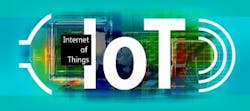CTIA/GSMA presenter says future connectivity, interoperability and security problems could plague disjointed IoT networks
The often overlooked need to adopt broad Internet of Things (IoT) interoperability and connectivity standards was highlighted by iconectiv CTO Chris Drake at the debut of GSMA’s Mobile World Congress Americas conference today in San Francisco, CA.
As the authoritative partner of the global communications industry, connecting more than two billion people every day, iconectiv has extensive experience in the crucial role that authentication protocols for devices and apps play in securing digital ecosystems. Intended as a call to action for device and application vendors, system integrators, network operators and service providers, the company contends that Drake’s presentation comes at a crossroads in the development of machine-to-machine communications.
Per iconectiv, "SmartAmerica estimates city governments alone will invest approximately $41 trillion over the next 20 years to upgrade existing infrastructures in order to benefit from the IoT. This costly and monumental endeavor leaves industrial, utility, enterprise and government leaders pondering how best to advance IoT and smart city implementations around the world. With recent estimates putting the number of IoT connected devices at 22 billion by 2020, the task at hand for device and application vendors and smart city planners is staggering. Additionally, each new device and application entering the IoT brings unique connectivity and security intricacies that are vital to ensuring ecosystem integrity."
“This is a crucial stage for IoT implementations, when the foundation for long lasting IoT infrastructure and interoperability will be set. The decisions we make today will define the way the world connects and communicates for generations ahead,” said iconectiv's Drake.
One key step to address this issue advised by Drake is a shift from current proprietary technical implementations and manual, if not weak, application of device enrollment security, toward scalable and consistent standards-based architectures. iconectiv notes that initial IoT developments focused on individual devices and single-purpose applications, and lacked a cohesive or truly interoperable infrastructure and security. This resulted in a fragmented ecosystem that does not offer the functionality and security that consumers and businesses will expect. Drake’s presentation offered developers a roadmap to build collaborative devices and applications where trust essential to interoperability can be managed at scale in the IoT.
In addition to his prominent role at iconectiv, Chris Drake serves on the board and executive committee of the Alliance for Telecommunications Industry Solutions (ATIS) and the board of directors for the Telecommunications Industry Association (TIA).
